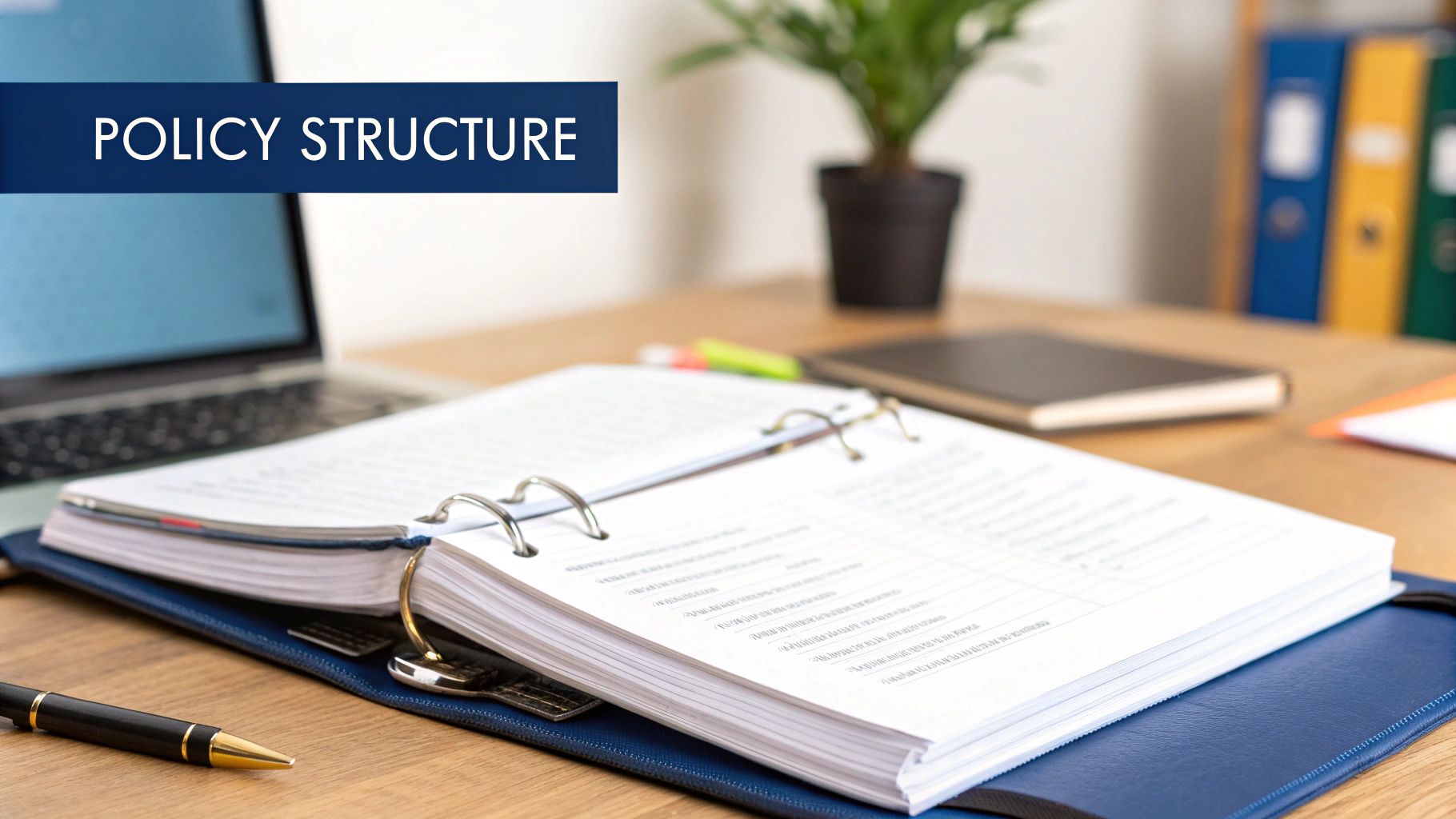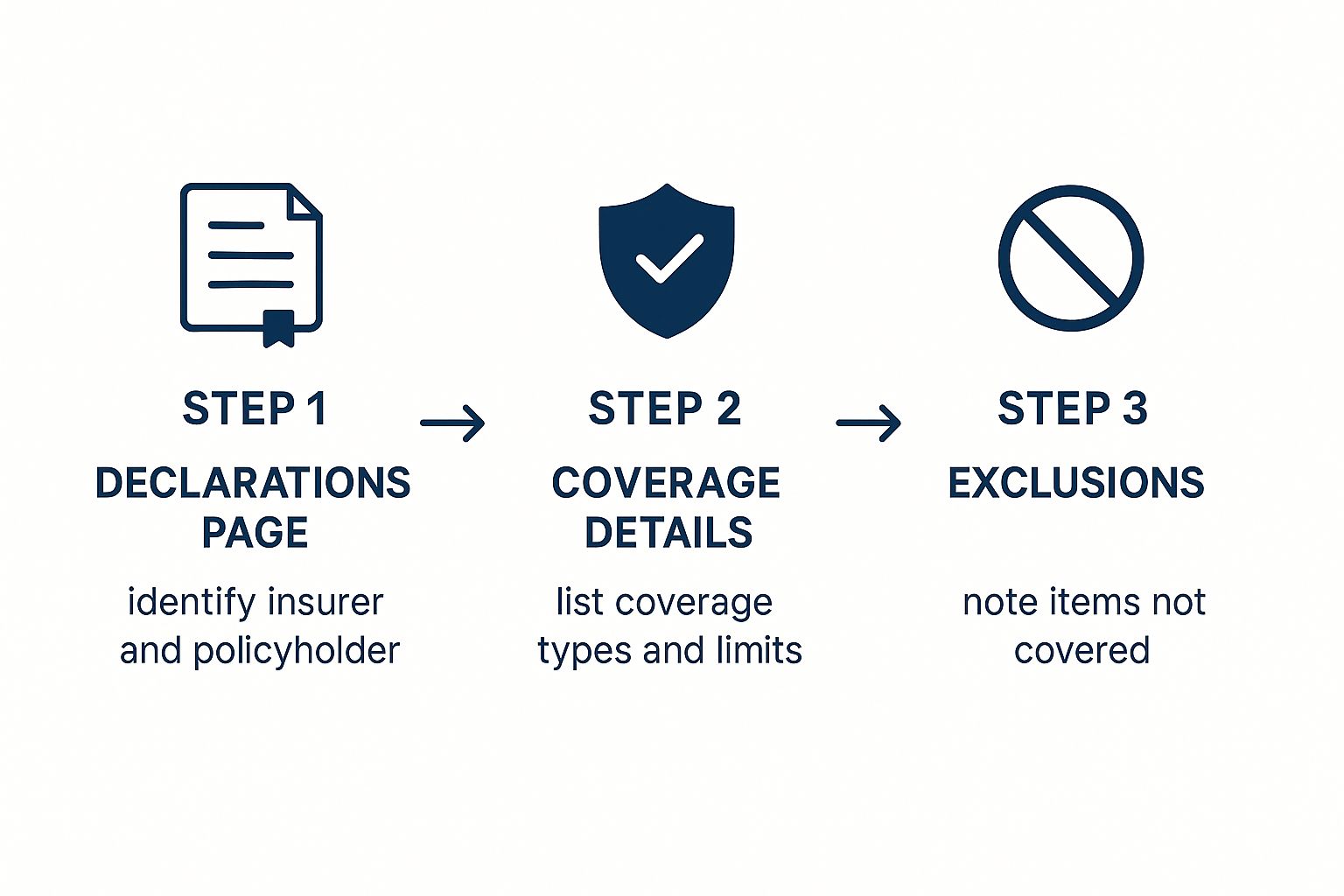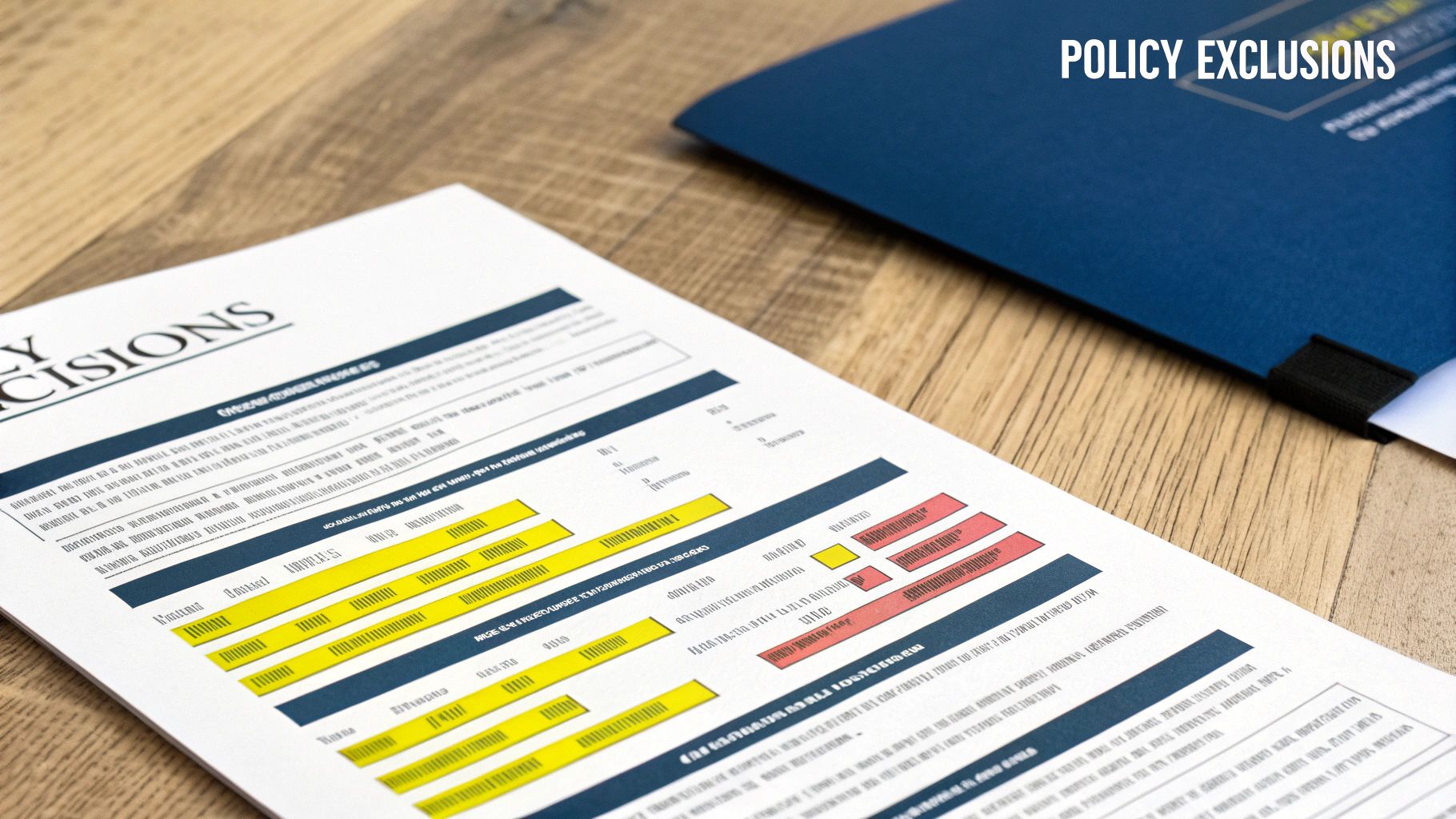How to Read Insurance Policy: A Simple Guide
- dustinjohnson5
- Oct 6
- 11 min read
Let's be honest, getting a new insurance policy in the mail can feel a bit like homework. It’s dense, full of jargon, and it's tempting to just file it away. But before you do anything else, pull out the very first page—the Declarations Page.
Think of this page as the executive summary of your entire insurance contract. It’s where all the most important details are laid out in one spot. If you can get a handle on this one page, you’re already halfway to understanding what you're actually paying for.
Your Guide to the Insurance Declarations Page
This isn't just a cover sheet; it's the personalized part of your policy. While the rest of the document contains standardized legal language, the "dec page," as it's often called in the industry, lists the specifics that apply directly to you. It’s the who, what, where, when, and how much of your coverage.

Getting this part right is absolutely critical. A simple typo in your name or a wrong digit in your car’s VIN might seem minor, but it can create huge headaches and delays when you need to file a claim. Treat this page as your first line of defense.
What to Verify First
Grab a highlighter and run through this checklist as soon as you get your policy documents. These are the non-negotiables:
Named Insured: Is your name spelled correctly? Are all the right people (like your spouse or business partners) listed? This confirms exactly who the policy protects.
Policy Number and Period: This unique number is your account ID. You'll need it for everything from paying a bill to filing a claim. Also, double-check the effective and expiration dates to make sure you don't have any surprise gaps in coverage.
Covered Property or Risks: For auto insurance, this section will list the make, model, and VIN for each vehicle. For a homeowner's policy, it's your property address. Make sure it's all 100% accurate.
Coverage Limits and Deductibles: Here’s where you see the numbers. The limit is the maximum your insurer will pay for a claim. The deductible is the amount you have to pay out of your own pocket first.
Premium Amount: This is the bottom line—what the coverage is going to cost you for the policy term.
One of the main challenges when learning how to read an insurance policy is the increasing complexity of the global insurance market. Total global premiums recently reached EUR 7.0 trillion, with distinct segments like life, P&C, and health all having vastly different terms. This underscores why mastering your policy's terminology is vital. Discover more about the global insurance market and its complexities.
Before we move on, let's quickly break down where the Declarations Page fits into the bigger picture. Every policy is built from several standard components, each serving a distinct purpose.
Key Sections of Your Insurance Policy at a Glance
This table gives you a quick snapshot of the different parts of a typical policy and what to look for in each one.
Policy Section | What to Look For | Why It Matters |
|---|---|---|
Declarations | Your name, policy dates, coverage limits, deductibles, premium. | This is the personalized summary of your unique contract. Errors here can invalidate claims. |
Insuring Agreement | The insurer's core promise to pay for covered losses. | It defines the fundamental "bargain" between you and the insurance company. |
Exclusions | What is not covered (e.g., floods, earthquakes, intentional acts). | This section prevents misunderstandings by clearly stating the limits of the policy. |
Conditions | Your responsibilities (e.g., paying premiums, reporting claims). | Failure to meet these conditions can give the insurer grounds to deny your claim. |
Definitions | Explanations of key terms used throughout the policy. | Clears up any ambiguity in the policy language so everyone is on the same page. |
Endorsements | Add-ons or modifications that change the standard policy. | These riders tailor the policy to your specific needs, adding or removing coverage. |
Understanding how these sections work together is the key to truly grasping what your insurance does—and doesn't—cover.
Getting to the Heart of Your Coverage
Once you move past the Declarations Page, you're getting into the real meat of your policy. The first stop is the Insuring Agreement. This is the insurer's legally binding promise to you. It's the core "if this happens, then we'll do that" statement that forms the basis of your entire contract.
For example, a standard auto policy's insuring agreement will lay out the promise to pay for damages from a "collision" or an event "other than collision." This is the clause that officially activates your coverage. Really getting a handle on this section tells you exactly when you can (and can't) expect your insurer to step in.
Why the Definitions Section is Crucial
Right after the insuring agreement, you'll hit the Definitions section. It might look like just a glossary, but don't skim it. This is one of the most powerful parts of your policy because it’s where the insurance company spells out precisely what certain words mean. Terms you think you know, like "accident," "residence," or even "family member," are given very specific, legally binding meanings.
A policy might define an "accident," for instance, as a sudden and unintended event. Why does that matter? Because a slow, gradual water leak from an old pipe might not fit that definition, leaving you without coverage. The words here aren't up for debate—they're the rules of the game.
Never assume a word in your policy has its everyday meaning. The insurer's definition is the only one that counts in a claim, and overlooking that is a classic and expensive mistake.
Your Responsibilities: Understanding the Conditions
Next up is the Conditions section. Think of this as your side of the deal—the list of rules you have to follow to keep your coverage active and valid. If you don't stick to these, the insurer could have grounds to deny your claim, even if it's for a covered event.
Here are a few of the big ones you'll always see:
Prompt Notice of Loss: You’re required to report any potential claim as soon as you reasonably can. Don't wait.
Cooperation Clause: You have to work with the insurer during their investigation. This might mean providing documents, photos, or giving a recorded statement.
Subrogation: This is a big one. It gives your insurance company the right to go after the person or party who was actually at fault to get back the money they paid you.
The fine print here is more important than ever. I’ve seen how outside events can change the game. For example, U.S. tariffs have driven up repair costs for cars and construction materials, which in turn has led insurers to bake more complex conditions and exclusions into their policies. You need to read carefully to see how global trends might trickle down and impact your specific claim. Learn more about how world events impact insurance policies.
Making Sense of Policy Limits and Deductibles
All those numbers on your declarations page? They’re just as crucial as the fine print. Two figures, in particular, dictate what you'll actually pay when something goes wrong: your policy limits and deductibles. Getting a handle on these is the key to avoiding nasty financial surprises when you need to file a claim.
Think of a policy limit as the absolute ceiling on what your insurance company will pay for a covered loss. You’ll usually see a couple of different types.
A "per-occurrence" limit is the maximum payout for a single incident. Let's say you're in a fender-bender that turns into a multi-car pile-up—this is the most your policy will pay for that entire event, no matter how many cars are involved.
An "aggregate" limit" is the total your insurer will pay out across the entire policy period, which is typically one year.
Deductibles: The Part You Pay
Your deductible is the portion of the bill you have to cover yourself before your insurance starts paying. It's your skin in the game.
For example, if a storm damages your roof and the repair bill is $2,000, and you have a $500 deductible, you’ll pay that first $500. Your insurer then picks up the remaining $1,500, assuming it’s within your policy limit.

As you can see, once you’ve confirmed the basics on the declarations page, your focus should shift straight to these numbers—what’s covered, what isn’t, and for how much.
There's always a trade-off here. A higher deductible usually means you’ll pay a lower premium, and vice-versa. It’s a balancing act. You have to weigh what you can comfortably pay each month against what you could afford to shell out unexpectedly after a claim.
And when you're thinking about potential claim payouts, it's also important to understand concepts like Actual Cash Value (ACV), as this calculation often determines the final amount you receive for damaged property.
Finding What Your Insurance Policy Excludes
It's one thing to know what your insurance policy covers. It’s arguably more important to know what it doesn't. This is where you need to flip to the Exclusions section. Think of it as the fine print that draws the absolute boundaries of your protection.
This section is a straightforward list of all the events, situations, and perils your insurer simply will not pay for. Period.

So many homeowners are shocked to find out that standard policies don't cover damage from floods or earthquakes. These events are so catastrophic and widespread that insurers carve them out into separate, specialized policies. Skipping over the exclusions section is probably the single biggest mistake people make when trying to understand their coverage.
Common Exclusions to Look For
While the details vary, most insurance policies exclude the same kinds of things. The reasoning is pretty consistent: the risk is either too predictable (like wear and tear), too massive (like war), or better handled by a different type of policy.
Keep an eye out for these usual suspects:
Earth Movement: This is a catch-all for earthquakes, landslides, mudslides, and sinkholes.
Flooding: Damage from rising water—whether from a hurricane surge or an overflowing river—is almost always excluded. You'll need a separate flood insurance policy for that.
Intentional Acts: If you deliberately damage your own property to file a claim, that’s fraud, and it’s not covered.
Neglect: Your policy assumes you'll handle basic upkeep. If you ignore a leaky roof for months and it leads to major water damage, the insurer can deny the claim based on neglect.
War and Nuclear Hazard: These large-scale disasters are considered uninsurable by private companies.
An exclusion isn't a maybe; it’s a hard "no" from your insurance company. If a peril is listed here, you have zero coverage for it under your base policy.
Tailoring Your Coverage with Endorsements
So, what do you do about these coverage gaps? That's where endorsements (also called riders) come in. These are small amendments you can add to your policy to plug a hole, either by adding back a specific exclusion or by increasing a coverage limit.
For example, a standard policy might only cover jewelry up to $1,500. If you have an expensive engagement ring, you can add a "scheduled personal property" endorsement to insure it for its full appraised value. Another common one is an endorsement for sewer and drain backup, which is a frequent exclusion that can cause a world of expensive trouble.
Think of your main policy as the off-the-rack suit. Endorsements are the tailoring you get to make sure it fits you perfectly. By carefully reading your exclusions, you can spot your vulnerabilities and add the specific protections you actually need.
A Practical Checklist for Your Annual Policy Review
Think of your insurance policy as a living document. It's not a "set it and forget it" kind of thing. Life changes, and your coverage needs to change right along with it. What was a perfect fit last year could leave you dangerously exposed today, which is why an annual review isn't just a good idea—it's essential for your financial health.
Before that renewal notice hits your mailbox, block out some time to give your policy a once-over. And I don't just mean glancing at the premium. Dig into the details. Do your property and liability limits still reflect your current net worth? A quick check-in now can save you a world of hurt later.

When to Call Your Agent Immediately
Sometimes, you can't wait for that annual review. Certain life events demand an immediate call to your agent because they can throw your existing coverage completely out of whack.
Don't hesitate to pick up the phone if you've:
Done Major Renovations: Finished the basement or added a new deck? That's great, but it also just increased your home's replacement value. Your old coverage limit won't be enough to rebuild if something happens.
Started a Side Business: That new Etsy shop or consulting gig you're running from home brings new liability risks. A standard homeowner's policy almost certainly won't cover business-related claims.
Acquired High-Value Items: If you’ve inherited Grandma's diamond ring or finally bought that piece of art you've always wanted, you’ll likely need a special endorsement. Most policies have surprisingly low limits—often around $1,500—for things like jewelry and collectibles.
Keeping Your Documents Organized
Knowing how to read your policy is one thing; being able to find it in the middle of a crisis is another. The best advice I can give is to have a dedicated spot for all your insurance paperwork, whether it's a physical folder or a digital one.
Pro Tip: Save a PDF of your declarations page to a secure cloud service like Google Drive or Dropbox. If you ever have to evacuate, you’ll have your policy number and agent’s contact info on your phone when you need it most.
When you do have that review call with your agent, go in with a few questions prepared. Ask them to walk you through a specific exclusion or to clarify exactly how your deductible would apply in a real-life scenario. This small step ensures that what you think you're covered for is actually what's written in the policy.
Common Questions About Reading Insurance Policies
Even after you've broken down the main sections of your policy, a few questions always seem to pop up. Let's tackle some of the most common points of confusion so you can feel completely confident in the coverage you have.
How Often Should I Reread My Entire Policy?
Think of it like an annual check-up. You should sit down and give your policy a full, line-by-line review at least once a year, usually right before it’s set to renew. This is your prime opportunity to spot any changes your insurer might have slipped in and, more importantly, to make sure the coverage still makes sense for your life.
Of course, you shouldn’t always wait for renewal day. A major life event should trigger an immediate policy review. Things like:
Getting married
Buying a new home or car
Making a major home renovation
Starting a business out of your home
Any of these can drastically change your insurance needs, so it’s crucial to get your policy updated right away.
What If I Still Don’t Understand Something?
Never, ever guess. If a specific term, clause, or condition has you stumped, your first call should be to your insurance agent or a company representative. It’s literally their job to help you understand the product you're buying.
To make the conversation productive, pinpoint the exact section you're struggling with before you pick up the phone. Asking for a practical, real-world example can make a world of difference. Getting clarity now can save you from the massive headache of a denied claim later.
The best way to learn is by asking specific questions. Instead of just saying, "I don't get this," try asking something like, "Can you walk me through how my $1,000 deductible would work if a storm causes $5,000 in wind damage to my roof?"
Is Reading the Declarations Page Good Enough?
The Declarations Page is a fantastic starting point—it's the cheat sheet for your policy. But relying on it alone is a mistake. It gives you the "what" (your coverage limits, who's insured, what's covered), but it completely skips the "how" and the "what if."
The real meat of your policy is in the fine print. The full document details all the critical exclusions, conditions, and definitions that set the actual boundaries of your coverage. To truly grasp what you’re protected from, you have to look at the whole picture. Beyond understanding the nuances of your current coverage, many people seek out information on ways to lower auto insurance premiums to manage their costs effectively.
At America First Financial, we believe in clear, straightforward protection for your family and assets, free from political agendas. Secure your financial future with insurance products designed to support your values. Get a no-hassle quote in under three minutes and discover the peace of mind that comes with reliable coverage. Find your plan today.
_edited.png)
Comments